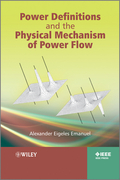
Power definitions and the physical mechanism of power flow
Emanuel, Alexander Eigeles
The book has six core chapters and six appendices to clarify the heavy mathematical aspects. Chapter 1 explains the electric energy flow and Chapter 2 deals with the single-phase system with sinusoidal waveforms. It provides a much needed review of basic concepts and introduces new definitions, such as instantaneous intrinsic power. Chapter 3 explains the single-phase systems with nonsinusoidal waveforms. It demostrates that the flow of instantaneous powers replicate the flow of Poynting vecotor components, this providing the essential background for a correct decision when the reader separates, or defines, the apparent power components. Chapter 4 discusses the major apparent power resolutions as advocated by different researchers through time, from C.I. Budeanu (1927)through to L. Czarnecki (1984) and the authors own methods put forward in 1995. The different methods are evaluated and compared with numerical examples, providing the reader with the knowledge needed to understand the features and limitations of the different approaches. Chapter 5 covers the transition to three-phase systems, and focuses on the sinusoidal balanced and unbalanced conditions. Two key concepts for both the IEE std. and the DIN standard are explained. The final chapter discusses the most popular definitions, either in use by the electric utilities, or recommended by the two major standards. All the most important and recent theories on the subject are shown and critically analysed. The book is logically organised, starting at an elementary level and becoming more complex.
- ISBN: 978-0-470-66074-4
- Editorial: John Wiley & Sons
- Encuadernacion: Cartoné
- Páginas: 256
- Fecha Publicación: 20/08/2010
- Nº Volúmenes: 1
- Idioma: Inglés
